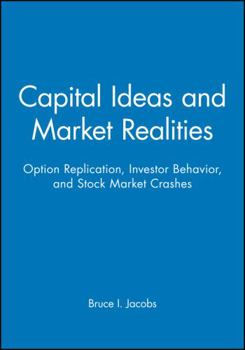Capital Ideas and Market Realities: Option Replication, Investor Behavior, and Stock Market Crashes
Select Format
Select Condition 
Book Overview
Bruce Jacobs sifts through the history of modern finance, from the efficient market hypothesis to behavioral psychology and chaos theory, to determine the cause of recent market crashes.
Format:Paperback
Language:English
ISBN:0631215557
ISBN13:9780631215554
Release Date:August 1999
Publisher:Wiley-Blackwell
Length:424 Pages
Weight:1.30 lbs.
Dimensions:0.9" x 6.0" x 9.0"
Customer Reviews
2 ratings
A Fascinating Work about Today's Financial Alchemy
Published by Thriftbooks.com User , 24 years ago
he book provides an extremely enlightening treatment of arcane financial strategies that have derived from Nobel Laureate winning option pricing theory. It is a well-written description of how very smart people are able to "outwit" other supposed very smart people by promising something for nothing. There will always be those who will dream up complicated strategies that purport to promise high return for low risk and thus demand a premium for providing their strategy. The book reminded me of Albert Einstein's work for the Swiss Patent Office at the turn of the century. He would daily receive applications for new and different perpetual motion ideas. Sometimes the ideas were so complicated Einstein could not readily find their flaw. (Finally, he encouraged the patent office to pass a ruling stating that anyone wishing to patent something which broke the second law of thermodynamics had to submit an actual working unit.) Portfolio insurance was the first large scale application of option pricing theory. Long-Term Capital Management, a highly leveraged hedge fund partnered by the Nobelists, was the second large scale application. Both promised free lunches. It is easy for the disciplined, long-term, individual investor to look at the 1987 crash and the LTCM debacle and conclude that it doesn't matter. The ones who were harmed the most were the purveyors of these supposed perpetual motion machines as well as the investors who "played with this fire". In fact, however, Jacobs' book is a wake-up call that these new financial strategies have become so far reaching, that they can have significant impact not only on the financial markets, but on the global economy as well. The missing element in the book is a way for regulators to rein in an industry that is out of control and return it to its basic purpose: moving money from people that have it (investors) to people that need it and educating the investor on the risk/reward tradeoffs. The industry subrole of shifting risk from people who cannot accept it (e.g. farmers) to those who can (speculators) is also valid, however, it has become so pervasive and sophisticated that it begs for a return to sanity. Absent that, Jacobs' book is an eye-opener, and a must read for anyone hoping to cope with today's complicated markets.
A Fascinating Work about Today's Financial Alchemy
Published by Thriftbooks.com User , 24 years ago
The book provides an extremely enlightening treatment of arcane financial strategies that have derived from Nobel Laureate winning option pricing theory. It is a well-written description of how very smart people are able to "outwit" other supposed very smart people by promising something for nothing. There will always be those who will dream up complicated strategies that purport to promise high return for low risk and thus demand a premium for providing their strategy. The book reminded me of Albert Einstein's work for the Swiss Patent Office at the turn of the century. He would daily receive applications for new and different perpetual motion ideas. Sometimes the ideas were so complicated Einstein could not readily find their flaw. (Finally, he encouraged the patent office to pass a ruling stating that anyone wishing to patent something which broke the second law of thermodynamics had to submit an actual working unit.) Portfolio insurance was the first large scale application of option pricing theory. Long-Term Capital Management, a highly leveraged hedge fund partnered by the Nobelists, was the second large scale application. Both promised free lunches. It is easy for the disciplined, long-term, individual investor to look at the 1987 crash and the LTCM debacle and conclude that it doesn't matter. The ones who were harmed the most were the purveyors of these supposed perpetual motion machines as well as the investors who "played with this fire". In fact, however, Jacobs' book is a wake-up call that these new financial strategies have become so far reaching, that they can have significant impact not only on the financial markets, but on the global economy as well. The missing element in the book is a way for regulators to rein in an industry that is out of control and return it to its basic purpose: moving money from people that have it (investors) to people that need it and educating the investor on the risk/reward tradeoffs. The industry subrole of shifting risk from people who cannot accept it (e.g. farmers) to those who can (speculators) is also valid, however, it has become so pervasive and sophisticated that it begs for a return to sanity. Absent that, Jacobs' book is an eye-opener, and a must read for anyone hoping to cope with today's complicated markets.





